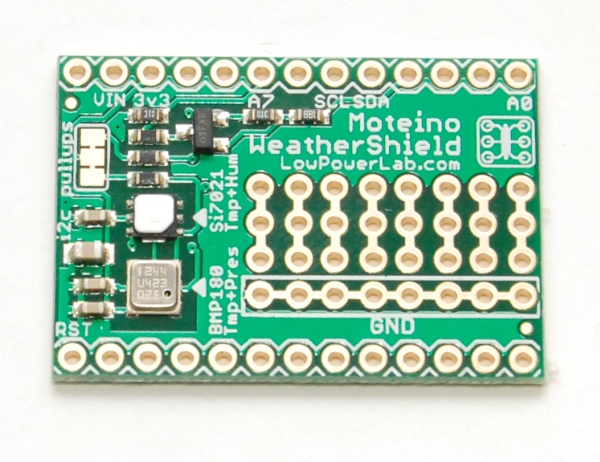
I was not happy with the performance of sensors like DS18B20 which were not only expensive for the limited functionality and accuracy they offered but also cripplingly slow (taking 1 second to read temperature, seriously Dallas?!).
So I created a new WeatherShield to measure temp/humidity/pressure accurately while also being very low power and very fast, now available to source assembled from here. These are highly accurate I2C temperature/humidity (Si7021) and atmospheric pressure (BMP180) sensors. Credit goes where it's due – this was inspired by this forum post and its author mr. A, but it's somewhat different than the one presented there. There is a sample sketch to read the data from this shield, and I will follow up with schematics and more details as they become available.
Some of the features:
- –40°C to +85 °C temperature range, 0-100% humidity range(Si7021).
- Best of all these sensors are very low power
- The Si7021 has an active conversion consumption of 150uA and standby of 60nA, and BMP180 ranges between 3-12uA in active mode and 0.1uA in standby.
- Fast sample times, far superior to sensors like DS18B20 which require along ridiculous sample reading time of up to 1s. By comparison Si7021 requires about 4-10ms sample conversion time depending on reading resolution (8-14bit)
- The shield can be stacked on/under a Moteino (not a MoteinoMEGA)
- Small prototyping area where you can add a little circuit, connect it to the Moteino pins through thin hookup wire
- BMP180 also gives temperature readings that are pretty good but it is primarily an atmospheric pressure sensor, and Si7021 has a magnitude better accuracy for temperature
- Onboard P-mosfet driven VIN/battery monitor. This is a VIN-4.7k+10K-GND voltage divider that can be enabled by setting A3 to OUTPUT LOW and reading the VIN voltage on A7, then disabling it to save power by setting A3 to INPUT (HighZ which disconnects any battery drain through this circuit).
These boards come at a price and instead they are precision sensors for serious weather monitoring enthusiasts and offer a set of features which makes them very battery/remote monitoring friendly and along with Moteino they can make a very small battery operated node.
Enjoy,
-Felix

Discussions
Become a Hackaday.io Member
Create an account to leave a comment. Already have an account? Log In.